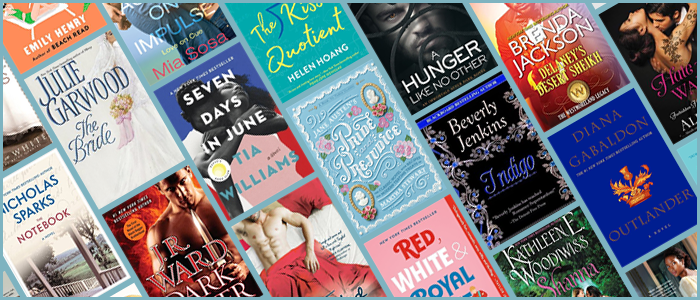


About Rules Buttons Join Fans Update Home
From love affairs set in England’s Regency era to contemporary sensual affairs, romance novels continually top the New York Times best-selling charts. These stories are aspirational, optimistic, and provide escapism.
Romance novels can be traced all the way back to ancient Greece, with five surviving stories centered on romantic love from this time. Samuel Richardson’s 1740 novel Pamela is also a precursor for the modern romance novel. In the nineteenth century, romance novels rose to prominence with the popular works of Jane Austen, whose novel Pride and Prejudice greatly influenced the genre.
According to the Romance Writers of America, the main plot of a mass-market romance novel must revolve about the two people as they develop romantic love for each other and work to build a relationship. Both the conflict and the climax of the novel should be directly related to that core theme of developing a romantic relationship, although the novel can also contain subplots that do not specifically relate to the main characters' romantic love. Furthermore, a romance novel must have an "emotionally satisfying and optimistic ending."
Others, including Leslie Gelbman, a president of Berkley Books, define the genre more simply, stating only that a romance must make the "romantic relationship between the hero and the heroine ... the core of the book." In general, romance novels reward characters who are good people and penalize those who are evil, and a couple who fights for and believes in their relationship will likely be rewarded with unconditional love. Bestselling author Nora Roberts sums up the genre, saying: "The books are about the celebration of falling in love and emotion and commitment, and all of those things we really want." Women's fiction (including "chick lit") is not directly a subcategory of the romance novel genre, because in women's fiction the heroine's relationship with her family or friends may be as important as her relationship with the hero.
There is a lot of controversy among romance authors about what should and should not be included in plots of romance novels. Some romance novel authors and readers believe the genre has additional restrictions, from plot considerations (such as the protagonists' meeting early on in the story), to avoiding themes (such as adultery). Other disagreements have centered on the firm requirement for a happy ending; some readers admit stories without a happy ending, if the focus of the story is on the romantic love between the two main characters (e.g., Romeo and Juliet). While the majority of romance novels meet the stricter criteria, there are also many books widely considered to be romance novels that deviate from these rules. The Romance Writers of America's definition of romance novels includes only the focus on a developing romantic relationship and an optimistic ending. Escapism is important; an Avon executive observed that "The phone never rings, the baby never cries and the rent's never overdue in romances." There are many publishers, libraries, bookstores, and literary critics who continue to go by the traditional definition of romance to categorize books.
A romance novel can be set in any time period and in any location. In recent years, romance novels have even expanded into the galaxy. There are no specific restrictions on what can or cannot be included in a romance novel. Even controversial subjects are addressed in romance novels, including topics such as domestic violence, addiction, and disability. The combination of time frame, location, and plot elements does, however, help a novel to fit into one of several romance subgenres. Despite the numerous possibilities this framework allows, many people in the mainstream press claim that "all [romance novels] seem to read alike." Stereotypes of the romance genre abound. For instance, some believe that all romance novels are similar to those of Danielle Steel, featuring rich, glamorous people traveling to exotic locations. Many romance readers disagree that Steel writes romance at all, considering her novels more mainstream fiction.
Mass-market or formulaic romance novels are sometimes referred to as "smut", and are the most popular form of modern erotica for women. While some romance novels do contain more erotic acts, in other romance novels the characters do no more than kiss chastely. The romance genre runs the spectrum between these two extremes. Because women buy 90% of all romance novels, most romance novels are told from a woman's viewpoint, in either first or third person.
Although most romance novels are about heterosexual pairings, there are romance novels that deal with same-sex relationships, and some participants in the book industry characterize books dealing with same-sex relationships as F/F, and M/M.
There are two types of romance novels with differing formats.
The category romance, also known as series romance, is issued as part of a sequential collection. The numbered books are released at regular intervals, usually monthly. Books in the series may share characters, similar themes, or settings. Harlequin/Mills & Boon is the largest distributor of category romance novels. Category romance novels are no more than 200 pages long. Successful category romance stories are tightly focused on the central love story, and subplots and minor characters are part of backstory.
The single-title romance is a novel that not published as part of a delineated line of books. These run longer, typically between 350 and 400 pages. Single-title romances are not always stand alone works, and can sometimes be connected to other stories or characters as part of an author’s own long-running series.
Because romance novels have just two guiding principles—a central love story and an optimistic ending—the genre can span into many different tones and styles. The subgenres of romance novels are defined by the story’s timeframe, plot elements, and location.
Sources: Masterclass.com and Wikipedia.org.